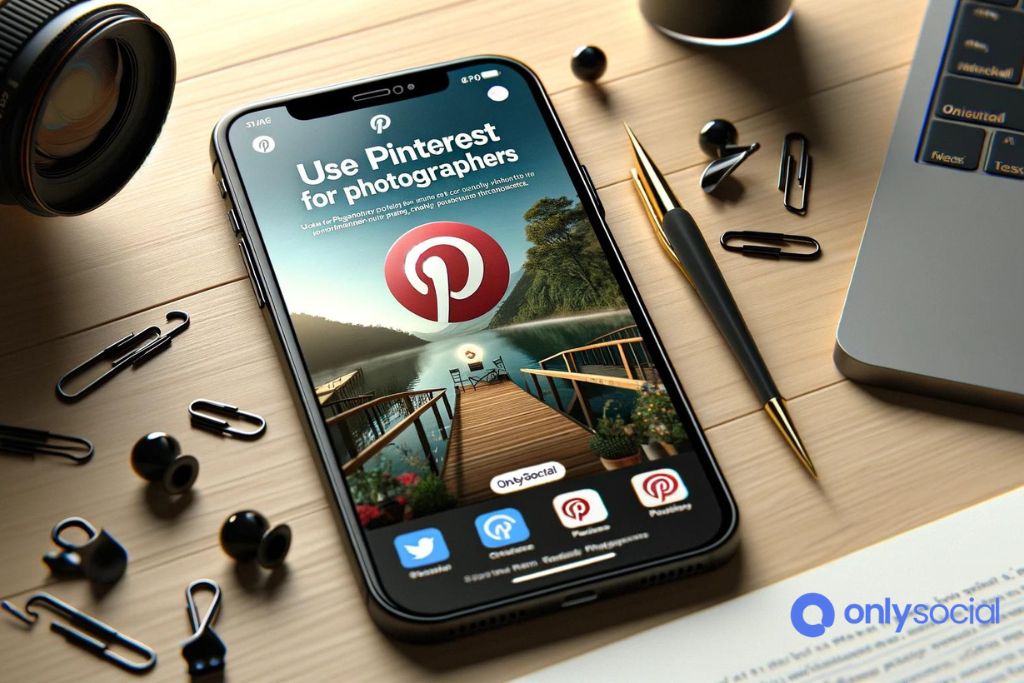In today’s digital age, photographers have a plethora of platforms to showcase their work, connect with audiences, and build their brands. Among these, Pinterest emerges as a uniquely valuable tool, offering visual artists a vibrant, expansive canvas to capture the perfect audience. “Use Pinterest for Photographers” isn’t just a guide; it’s a roadmap to navigating this visually rich platform, unlocking its potential to elevate your photography to new heights.
Pinterest, with its focus on visual discovery, is tailor-made for photographers looking to showcase their portfolios in a dynamic, engaging way. It goes beyond mere photo sharing; it’s about telling your story, one Pin at a time, to an audience eager to be inspired. Whether you’re a seasoned professional or an aspiring photographer, understanding how to use Pinterest effectively can transform the way you connect with your audience, share your work, and even drive traffic to your website or blog.
This guide is designed to demystify Pinterest for photographers, offering step-by-step instructions, tips, and strategies to make the most of this platform. From setting up your account with an eye for engagement to crafting Pins that captivate and convert, we’ll cover everything you need to know to start pinning your way to success. Let’s embark on this journey together, exploring how to use Pinterest not just as a tool, but as a canvas for your creative expression and a gateway to capturing the perfect audience for your photography.
Table of Contents
- 1 Understanding Pinterest: The Basics
- 2 Setting Up a Pinterest Account for Success
- 3 Crafting Pins That Capture Attention
- 3.0.1 A. Understanding the Anatomy of a Successful Pin
- 3.0.2 B. Image Selection and Optimization
- 3.0.3 C. Writing Descriptions That Draw In Viewers
- 3.0.4 D. Leveraging Editing Tools for Enhanced Visuals
- 3.0.5 E. Timing and Frequency of Pins
- 3.0.6 F. Engaging with the Pinterest Community
- 3.0.7 G. Tracking Performance and Adjusting Strategy
- 4 Strategies to Grow Your Audience on Pinterest
- 4.0.1 1. Optimize for Search: Mastering Pinterest SEO
- 4.0.2 2. Create High-Quality, Eye-Catching Pins
- 4.0.3 3. Leverage Pinterest Boards Effectively
- 4.0.4 4. Engage With the Pinterest Community
- 4.0.5 5. Utilize Pinterest Analytics to Understand Your Audience
- 4.0.6 6. Consistency is Key
- 4.0.7 7. Promote Your Pinterest Account on Other Platforms
- 5 Driving Traffic to Your Photography Website
- 6 Case Studies: Successful Photographers on Pinterest
- 7 Advanced Pinterest Strategies for Photographers
- 8 Common Mistakes to Avoid on Pinterest
- 9 BONUS
- 10 Frequently Asked Questions
- 10.0.1 How can I effectively use Pinterest for photographers to showcase my work?
- 10.0.2 What are the best practices for optimizing my Pinterest profile as a photographer?
- 10.0.3 How often should I Pin new content to attract and retain an audience?
- 10.0.4 What are the best times to post on Pinterest to maximize visibility for my photography?
- 10.0.5 How can I convert Pinterest followers into website visitors for my photography business?
- 10.0.6 Can I sell my photography directly on Pinterest?
Understanding Pinterest: The Basics

Pinterest serves as a unique platform blending social networking and visual bookmarking, where users can discover, save, and share ideas through images known as Pins. For photographers, understanding how to use Pinterest effectively is essential to showcase their work, inspire others, and attract a targeted audience interested in photography.
What is Pinterest?
At its core, Pinterest is a search and discovery network that allows users to explore content through visual Pins, which are often linked to websites, blogs, or other social media platforms. This visual nature makes it an ideal platform for photographers to display their portfolios, project ideas, and photographic inspirations.
How Does Pinterest Work for Photographers?
Photographers can use Pinterest to create a visual repository of their work, categorized into different boards based on themes, photography styles, or even color schemes. This organization helps potential clients or followers to navigate through a photographer’s portfolio easily, allowing them to find the specific style or inspiration they are seeking.
- Creating a Portfolio: Photographers can use Pinterest boards to create a visually appealing portfolio that showcases their best work. This portfolio can be categorized based on different photography styles, such as portrait, landscape, or wedding photography, making it easier for viewers to find the photographer’s work that most interests them.
- Inspiration and Trends: Pinterest is also a great place for photographers to stay updated on the latest photography trends and to find inspiration for their next projects. By following other photographers or photography-related boards, they can expose themselves to new ideas and creative concepts.
- Networking and Collaboration: Use Pinterest for photographers not only as a showcase platform but also as a networking tool. By engaging with other users through comments, repins, and messages, photographers can build relationships with peers, potential clients, and collaborators.
Key Terminology on Pinterest
Understanding Pinterest’s key terminology is crucial for photographers to navigate and utilize the platform effectively.
- Pins: The primary content type on Pinterest, Pins are images or videos that users can discover, save, and share. For photographers, each Pin can represent a piece of their work or inspiration they wish to share with their audience.
- Boards: Boards are collections of Pins that users can organize based on themes, ideas, or interests. Photographers can use boards to categorize their work by photography style, projects, or themes, making it easier for viewers to explore their portfolios.
- Repins: When a user saves a Pin from another user’s board to their own, it’s called a Repin. Repins are essential for photographers as they help increase the visibility of their work across the platform.
- Followers: Users who choose to follow another user’s profile or one of their boards. For photographers, gaining followers is crucial to building an audience on Pinterest and increasing the reach of their Pins.
By mastering these basics, photographers can start to leverage Pinterest to showcase their work, attract a dedicated audience, and engage with the photography community on a platform that values visual creativity and inspiration.
Setting Up a Pinterest Account for Success

A. Choosing the Right Type of Account
When you start to use Pinterest for photographers, deciding between a personal or business account is your first step. A business account offers analytics, advertising opportunities, and a professional appearance. It’s free to upgrade and essential for anyone serious about leveraging Pinterest professionally.
B. Optimizing Your Profile
Your profile is often the first point of contact with potential followers and clients, making its optimization crucial for success. Here are key elements to focus on:
- Profile Picture: Choose a high-quality, professional image that represents your brand. It could be your logo or a personal portrait if you’re the face of your brand.
- Bio: Your bio should succinctly convey who you are, what you specialize in, and what viewers can expect from your Pinterest page. Incorporate the keyword “use Pinterest for photographers” naturally, to enhance searchability.
- Links: Ensure you include a link to your photography website or portfolio. This directs potential clients to your work and increases traffic to your site.
C. Creating Your First Boards
Boards are where you organize your pins, and they play a critical role in attracting your target audience. Here’s how to create boards that resonate with viewers:
- Thematic Boards: Organize your pins into themes, such as “Wedding Photography,” “Landscape Shots,” or “Black and White Portraiture.” This organization helps users find exactly what they’re looking for.
- Seasonal Boards: Seasonal themes, like “Spring Weddings” or “Winter Landscapes,” can attract viewers looking for timely inspiration.
- Technique-Based Boards: Show off your expertise by creating boards based on photography techniques, such as “Long Exposure Photography” or “Macro Photography Tips.”
D. Engaging with the Community
Engagement is key to growing your audience on Pinterest. Start by following other photographers, photography enthusiasts, and brands you admire. Comment on and repin their content to start building a community around your brand.
E. Utilizing Keywords Effectively
To successfully use Pinterest for photographers, incorporate relevant keywords into your board names, pin descriptions, and profile. This improves your visibility in Pinterest searches. For example, use keywords like “photography tips,” “portrait photography,” and other terms your target audience might search for.
By carefully setting up your Pinterest account with a focus on appealing visuals, strategic organization, and community engagement, you can attract and captivate the perfect audience for your photography business.
Crafting Pins That Capture Attention
When you aim to use Pinterest for photographers effectively, creating pins that capture and retain attention is crucial. These visual bookmarks not only showcase your work but also act as a gateway to your online portfolio or photography website. Below are detailed steps and tips to ensure your pins stand out in a crowded field.
A. Understanding the Anatomy of a Successful Pin
- High-Quality Images: The cornerstone of any pin, especially for photographers. Ensure images are high-resolution, well-composed, and brightly lit.
- Compelling Descriptions: Use descriptive language that includes keywords related to the pin. “Sunset Photography Tips” is more enticing and searchable than just “Photography Tips.”
- Relevant Hashtags: Similar to descriptions, hashtags improve discoverability. Include photography-specific hashtags like #NaturePhotography, #WeddingPhotography, etc.
B. Image Selection and Optimization
- Subject Focus: Choose images that have a clear focus point. Images that tell a story or evoke emotion tend to perform better.
- Aspect Ratio: Pinterest prefers vertical images with a 2:3 ratio (1000×1500 pixels is ideal) as they take up more space on viewers’ feeds, making them more noticeable.
- Branding: Subtly incorporate your brand or watermark. It should be noticeable but not distracting.
C. Writing Descriptions That Draw In Viewers
- Keyword-Rich Texts: Incorporate keywords naturally into your pin descriptions. For photographers using Pinterest, terms like “photography tips,” “photo editing,” or “landscape shots” can be effective.
- Call to Action (CTA): Encourage users to click through to your website or portfolio with a clear CTA, such as “Discover more photography tips on our site.”
D. Leveraging Editing Tools for Enhanced Visuals
- Editing Software: Utilize photo editing software to adjust brightness, contrast, and saturation to make your images pop.
- Templates and Tools: Consider using templates from Canva or Adobe Spark to maintain consistency in your pins’ appearance, which helps in brand recognition.
E. Timing and Frequency of Pins
- Consistency Is Key: Regularly pinning is crucial for engagement. Aim for a consistent schedule rather than sporadic bursts of activity.
- Best Times to Pin: Use Pinterest analytics to find when your audience is most active. Generally, evenings and weekends are peak times for Pinterest users.
F. Engaging with the Pinterest Community
- Repinning and Commenting: Engage with other users by repinning their content and leaving thoughtful comments. This builds community and can lead to more visibility for your pins.
G. Tracking Performance and Adjusting Strategy
- Analytics: Use Pinterest Analytics to track which pins are performing best. Look at metrics like repins, click-throughs, and impressions.
- Adjust Based on Data: If certain types of images or descriptions are consistently outperforming others, adjust your strategy to focus more on what works.
Creating pins that capture attention is both an art and a science. By using Pinterest for photographers with a strategic approach to crafting your pins, you can significantly increase your visibility and engagement on the platform.
Strategies to Grow Your Audience on Pinterest

1. Optimize for Search: Mastering Pinterest SEO
- Keywords are Key: Incorporate relevant keywords, including “Use Pinterest for Photographers,” in your board titles, Pin descriptions, and profile information to improve visibility.
- Descriptive Titles and Captions: Write clear, compelling descriptions for your Pins that include keywords without keyword stuffing.
- Utilize Hashtags: Although Pinterest is not hashtag-driven like other social platforms, using a few relevant hashtags can help categorize your content and increase its discoverability.
2. Create High-Quality, Eye-Catching Pins
- Visual Appeal: Since Pinterest is a visual platform, high-quality, visually appealing images are crucial. Use editing tools to enhance your photos before pinning.
- Vertical Images: Pins with a vertical aspect ratio (2:3) tend to perform better, as they take up more screen space, increasing engagement.
- Text Overlays: For instructional or educational content, consider adding a text overlay with key information or a catchy title that includes your focus keyword.
3. Leverage Pinterest Boards Effectively
- Thematic Boards: Create boards that cater to specific themes or interests related to photography, such as “Wedding Photography Inspiration” or “Landscape Photography Tips.”
- Board Descriptions: Utilize board descriptions to include keywords and explain the board’s focus, helping to attract a targeted audience interested in those themes.
4. Engage With the Pinterest Community
- Follow Relevant Accounts: Use Pinterest for photographers by following other photography accounts, and engaging with their content through likes, comments, and repins.
- Participate in Group Boards: Join or create group boards related to photography to share your content with a broader audience and engage with other photographers.
5. Utilize Pinterest Analytics to Understand Your Audience
- Track Pin Performance: Monitor which Pins and boards are performing well to understand what your audience prefers.
- Audience Insights: Use Pinterest’s Audience Insights tool to learn more about your audience’s demographics, interests, and behavior on the platform.
6. Consistency is Key
- Regular Pinning Schedule: Maintain a consistent pinning schedule to keep your audience engaged and attract new followers. Tools like Tailwind can help schedule Pins at optimal times.
7. Promote Your Pinterest Account on Other Platforms
- Cross-Promotion: Share your Pinterest account on your website, blog, and other social media platforms to draw followers from other sources.
- Embed Pins: Use Pinterest for photographers by embedding Pins in your blog content, making it easy for readers to discover and follow your Pinterest profile.
By implementing these strategies, photographers can effectively use Pinterest to grow their audience, showcase their work, and drive traffic to their website or portfolio.
Driving Traffic to Your Photography Website
In the realm of digital marketing for visual artists, understanding how to use Pinterest for photographers can be a game-changer. This platform not only showcases your portfolio to a broad audience but also drives significant traffic to your photography website. Here’s how to harness Pinterest’s potential effectively:
Creating Pins That Link Back to Your Website
- Direct Links in Pin Descriptions: Ensure each Pin includes a direct link to your website. This can be to a blog post, a portfolio page, or a specific photo gallery. The goal is to make it as easy as possible for viewers to find more of your work.
- Use High-Quality Images with Watermarks: Your Pins should represent the best of your photography. Use high-resolution images and consider adding a subtle watermark with your website URL. This not only protects your work but also promotes your brand.
Optimizing Your Pins for Click-Throughs
- Compelling Call-to-Actions (CTAs): Your Pin descriptions should include a clear CTA encouraging users to click through to your website. Phrases like “Explore the full gallery on my website” or “Learn more about this photo shoot” can entice users to engage further.
- SEO Strategies: Incorporating relevant keywords into your Pin titles and descriptions can improve visibility. Research keywords related to your photography niche and include them naturally in your content.
Creating Boards That Reflect Your Website’s Structure
- Mirror Your Website’s Portfolio: Create Pinterest boards that reflect the different sections of your website, such as wedding photography, nature shots, or urban landscapes. This organized approach helps users navigate your portfolio more easily.
- Board Descriptions: Use board descriptions to hint at what users can find on your website, encouraging them to visit for a deeper dive into your work.
Leveraging Pinterest Analytics
- Track Which Pins Drive Traffic: Use Pinterest Analytics to identify which Pins and boards are most effective at driving users to your site. Analyze the data to understand what works best and refine your strategy accordingly.
- Understand Your Audience: Pinterest Analytics can also provide insights into your audience’s interests and behaviors. Use this information to tailor your content and website offerings to better meet their needs.
Promotional Strategies
- Seasonal Promotions: Take advantage of seasonal trends or holidays by creating promotional Pins that link back to related content or special offers on your website.
- Exclusive Pinterest Content: Offer content that is exclusive to Pinterest users, such as behind-the-scenes photos or early access to new galleries, to incentivize visits to your website.
Case Studies: Successful Photographers on Pinterest
Case Study 1: The Landscape Maestro
- Overview: A landscape photographer who leveraged Pinterest to triple website traffic within six months.
- Strategies Used:
- Curated Boards: Created separate boards for different landscapes (mountains, beaches, forests) to cater to niche interests.
- High-Quality Pins: Ensured each Pin was a high-resolution image with detailed descriptions, incorporating the keyword “Use Pinterest for Photographers” to attract aspiring photographers.
- SEO Practices: Focused on keyword optimization in Pin titles and descriptions, making it easier for Pinterest users searching for photography tips or landscape photos to find their content.
- Results: Noticed a significant increase in followers, repins, and clicks to the website. The high engagement rates led to more workshop sign-ups and print sales.
Case Study 2: The Wedding Photography Wizard
- Overview: Specializing in wedding photography, this photographer used Pinterest to showcase their portfolio and attract clients.
- Strategies Used:
- Event-Based Boards: Created boards for different types of weddings (beach, traditional, modern) to showcase versatility.
- Behind-the-Scenes Pins: Shared behind-the-scenes shots of wedding shoots, offering tips on how to use Pinterest for photographers looking to break into wedding photography.
- Collaborations: Partnered with wedding planners and bridal shops on Pinterest to cross-promote content, expanding reach.
- Results: Achieved a 40% increase in inquiries from potential clients via Pinterest. The platform became a primary source of new business, surpassing traditional advertising methods.
Case Study 3: The Urban Explorer
- Overview: An urban photography enthusiast with a knack for capturing cityscapes and street life, turning Pinterest into a digital gallery.
- Strategies Used:
- Themed Boards: Organized content into specific urban themes (street art, city nightscapes, daily life) to attract specific interest groups.
- Engagement Strategies: Used the “Use Pinterest for Photographers” tagline to engage with other photographers in the comments section, building a community of urban photography lovers.
- Pinterest Stories and Video Pins: Utilized newer Pinterest features to share stories behind the photos, increasing engagement and time spent on their Pins.
- Results: Gained international recognition, with several photos going viral. This exposure led to invitations for gallery showings and increased print sales directly through Pinterest.
Case Study 4: The Nature and Wildlife Pro
- Overview: A photographer focusing on nature and wildlife, using Pinterest to raise awareness about conservation while showcasing their work.
- Strategies Used:
- Educational Boards: Created boards that mix stunning wildlife photography with educational content about species and conservation efforts, incorporating tips on how to use Pinterest for photographers with a cause.
- Engagement Through Stories: Shared the stories behind encounters with wildlife, emphasizing the emotional connection to nature and photography.
- Community Building: Fostered a community of conservationists, nature lovers, and photographers by actively engaging in discussions and sharing resources.
- Results: Not only did their follower count skyrocket, but they also managed to raise significant awareness and funds for conservation projects through their Pinterest presence.
These case studies demonstrate the versatility and power of Pinterest as a platform for photographers to showcase their work, engage with a dedicated community, and achieve specific business or personal goals. By strategically using Pinterest, photographers can significantly enhance their online presence and reach their perfect audience.
Advanced Pinterest Strategies for Photographers
As photographers aim to elevate their presence and reach on Pinterest, incorporating advanced strategies into their marketing plan is crucial. Here are some sophisticated tactics that can help you maximize the use of Pinterest for photographers, ensuring your work not only garners attention but also drives meaningful engagement and traffic to your website or portfolio.
A. Leveraging Rich Pins
- What are Rich Pins: Explanation of Rich Pins and their benefits for photographers.
- Types of Rich Pins: Focus on Article, Product, and Recipe Pins and how they can be utilized by photographers.
- Setting up Rich Pins: Step-by-step guide to applying for and implementing Rich Pins to showcase your photography work more effectively.
B. Pinterest SEO Optimization
- Keyword Research: Techniques for finding and incorporating keywords related to photography into your Pins, boards, and profile.
- Optimizing Descriptions: How to craft compelling, keyword-rich descriptions for your Pins.
- Using Hashtags Wisely: Best practices for selecting and using hashtags to improve the discoverability of your photography.
C. Pinterest Ads for Photographers
- Introduction to Pinterest Ads: Overview of advertising options available on Pinterest and their relevance to photographers.
- Creating Effective Ad Campaigns: Tips for designing visually appealing ads that resonate with your target audience.
- Targeting and Retargeting: Strategies for targeting your ads to reach the right audience, including the use of retargeting to engage users who have previously interacted with your content.
D. Collaborative Boards and Partnerships
- Building Collaborative Boards: How to create and manage collaborative boards with other photographers or related businesses.
- Partnership Opportunities: Identifying and establishing partnerships with brands, influencers, and other photographers to expand your reach.
E. Analytics and Performance Tracking
- Understanding Pinterest Analytics: A guide to the analytics dashboard and the key metrics to track.
- Evaluating Your Strategy: How to use data from Pinterest Analytics to refine and adjust your strategy for better results.
- A/B Testing: Implementing A/B testing to determine the most effective Pins, descriptions, and images.
F. Integrating Pinterest with Your Photography Website
- Pinterest Save Button: Adding a Pinterest save button to your website to encourage visitors to pin your work.
- Embedding Pins and Boards: How to embed Pinterest Pins and boards on your website for increased engagement.
- Promoting Your Pinterest Account: Strategies for promoting your Pinterest presence through your website and other social media platforms.
By implementing these advanced Pinterest strategies, photographers can significantly enhance their visibility and engagement on the platform. From optimizing content with SEO best practices to leveraging advertising and analytics, these tactics will help you more effectively use Pinterest for photographers, ultimately leading to greater exposure for your work and more opportunities to connect with your target audience.
Common Mistakes to Avoid on Pinterest
When you aim to use Pinterest for photographers effectively, it’s crucial to be aware of common pitfalls that can hinder your growth and engagement on the platform. Avoiding these mistakes can help you maximize your presence and reach your target audience more efficiently. Here are several key mistakes to steer clear of:
Overlooking the Importance of SEO
- Ignoring Keywords: Failing to incorporate relevant keywords in your pin descriptions, board titles, and profile can significantly impact your visibility. Use Pinterest for photographers by researching and including keywords that potential clients are searching for.
- Neglecting Image SEO: Remember, Pinterest is a visual search engine. Use high-quality images with descriptive file names and alt texts to improve your content’s discoverability.
Neglecting Engagement with the Pinterest Community
- Isolation: Success on Pinterest isn’t just about posting your content. Engage with your audience by repinning relevant content, commenting on pins, and responding to comments on your pins.
- Ignoring Group Boards: Not participating in group boards can limit your reach. These boards are a great way to connect with other photographers and expose your work to a broader audience.
Inconsistency in Pinning
- Irregular Posting: Sporadic pinning can make it difficult to maintain and grow your audience. To effectively use Pinterest for photographers, establish and adhere to a consistent pinning schedule.
- Bulk Pinning: Conversely, uploading too many pins at once can overwhelm your followers. Spread out your posts to ensure maximum engagement.
Underestimating the Power of Analytics
- Ignoring Data: Pinterest provides valuable insights through its analytics feature. Not reviewing this data regularly means missing out on understanding what works for your audience, peak engagement times, and other critical metrics.
- Lack of Strategy Adjustment: Failing to adjust your strategy based on analytics insights can stall your growth. Use Pinterest for photographers by analyzing your most successful pins and boards, then replicate those strategies.
By avoiding these common mistakes, photographers can harness the full potential of Pinterest, growing their audience and directing more traffic to their work. Remember, success on Pinterest, like in photography, comes from paying attention to details, engaging with your community, and consistently delivering high-quality content.
BONUS
Hey there, social-savvy photographers! If you’re looking to up your game on Pinterest, you’re in the right place. With its visually captivating platform, Pinterest offers a goldmine for showcasing your photography skills and reaching your ideal audience. But navigating this bustling platform effectively requires strategy. That’s where OnlySocial comes in. Our Post Planning and Scheduling function streamlines your Pinterest content creation process, allowing you to effortlessly schedule posts ahead of time and ensure consistent engagement with your audience. With unlimited posting and the ability to manage multiple social profiles, OnlySocial is your ultimate tool for conquering Pinterest and beyond. Ready to elevate your social media presence? Start your commitment-free 7-day trial today!
Frequently Asked Questions
How can I effectively use Pinterest for photographers to showcase my work?
To effectively use Pinterest for photographers, start by creating visually appealing boards themed around different aspects of your work (e.g., wedding photography, landscapes, portraits). Ensure each Pin includes a high-quality image, a compelling description with relevant keywords, and a link back to your website or portfolio. Regularly update your boards with new Pins to keep your audience engaged.
What are the best practices for optimizing my Pinterest profile as a photographer?
Optimize your Pinterest profile by choosing a clear, professional profile picture, crafting a bio that highlights your expertise in photography, and including keywords related to your niche. Use a business account to access analytics and other features. Also, ensure your boards are well-organized and your Pins are tagged with relevant keywords to improve visibility.
How often should I Pin new content to attract and retain an audience?
For photographers using Pinterest, it’s recommended to Pin new content regularly to maintain visibility and engagement. Aiming for daily Pins is ideal, but ensure you’re focusing on quality over quantity. You can also use scheduling tools to maintain consistency without needing to be on the platform every day.
What are the best times to post on Pinterest to maximize visibility for my photography?
The best times to post on Pinterest vary depending on your target audience’s time zone and habits. Generally, evenings and weekends tend to have higher user engagement. Use Pinterest analytics to track when your Pins perform best and adjust your posting schedule accordingly to maximize visibility.
How can I convert Pinterest followers into website visitors for my photography business?
To convert Pinterest followers into website visitors, ensure each Pin links back to a relevant page on your website where viewers can see more of your work or contact you. Use clear call-to-actions (CTAs) in your PIN descriptions encouraging users to click through. Additionally, consider creating Pins that promote special offers or exclusive content available on your website to incentivize visits.
Can I sell my photography directly on Pinterest?
Yes, photographers can use Pinterest to sell their work directly through the platform by setting up Shop the Look Pins or by integrating their e-commerce platform with Pinterest. This allows users to purchase your photography or related products directly from your Pins. Make sure to follow Pinterest’s guidelines for merchants and optimize your Pins and boards for sales conversion.




